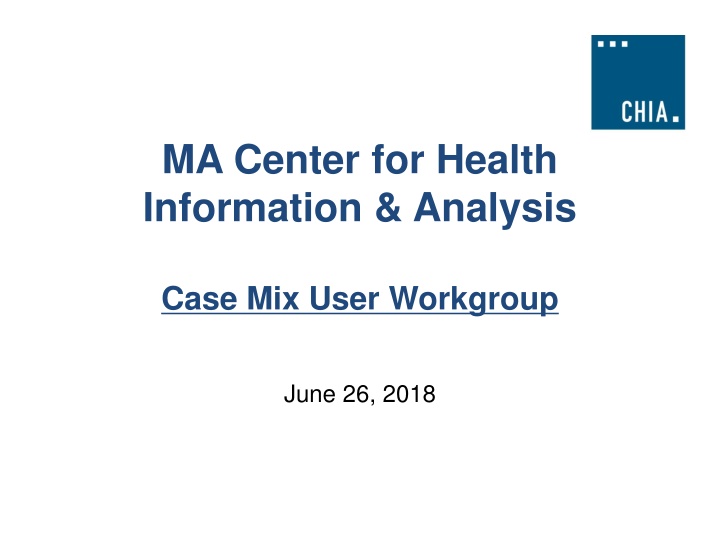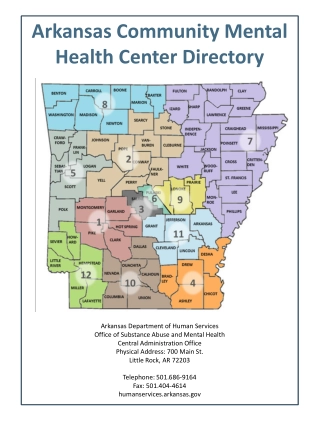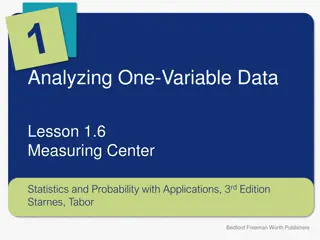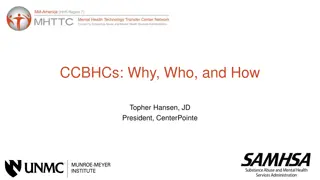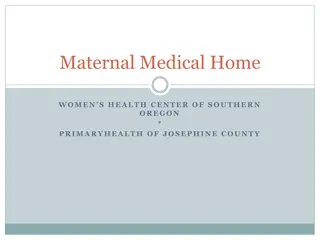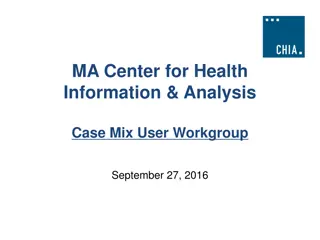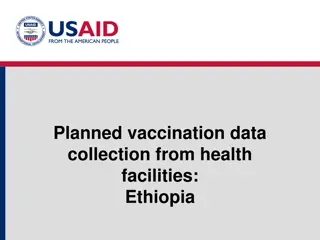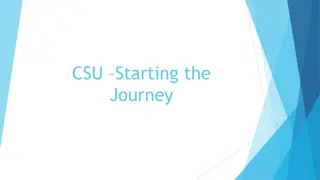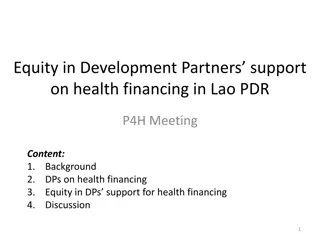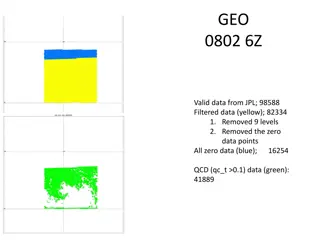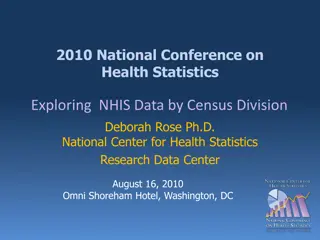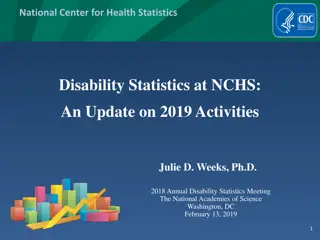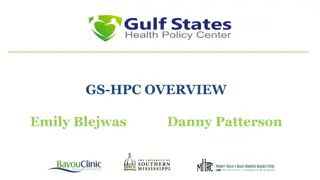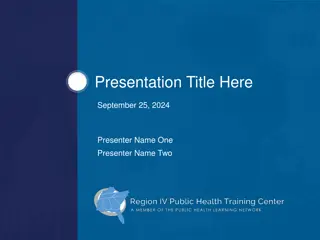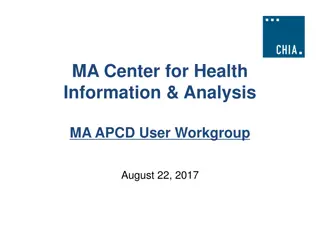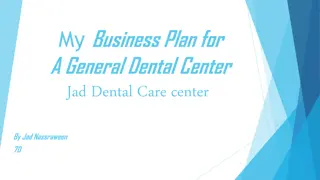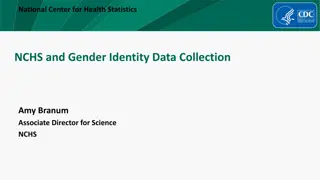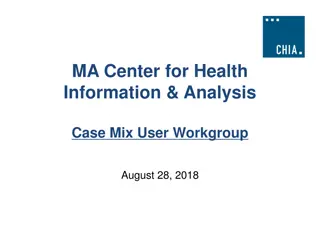MA Center for Health Information& Analysis
This content pertains to the Case Mix User Workgroup meeting held on June 26, 2018, providing insights into health information, analysis, and collaborative efforts towards enhancing healthcare services. It discusses topics related to data analysis, information sharing, and collaborative strategies aimed at improving healthcare outcomes.
Download Presentation

Please find below an Image/Link to download the presentation.
The content on the website is provided AS IS for your information and personal use only. It may not be sold, licensed, or shared on other websites without obtaining consent from the author.If you encounter any issues during the download, it is possible that the publisher has removed the file from their server.
You are allowed to download the files provided on this website for personal or commercial use, subject to the condition that they are used lawfully. All files are the property of their respective owners.
The content on the website is provided AS IS for your information and personal use only. It may not be sold, licensed, or shared on other websites without obtaining consent from the author.
E N D
Presentation Transcript
MA Center for Health Information & Analysis Case Mix User Workgroup June 26, 2018
Agenda Announcements Updates on FY17 Case Mix Data Release Summarized Data Reports User Questions: Impacts of lifting the limits on Case Mix diagnosis and procedure codes Use of Glasgow Coma Score in Case Mix data Q&A
Case Mix FY17 Release Calendar *CURRENT* RELEASE TIMEFRAMES FOR EACH FILE: Inpatient (HIDD) JUNE Emergency Department (ED) AUGUST Outpatient Observation (OOD) SEPTEMBER
Case Mix FY17 Data Release REPEAT APPLICANTS For those applicants with previously approved projects who indicated they would like to receive data annually, we began accepting Certificates of Continued Need and Compliance (Exhibit B of your DUA) starting on May 1st. After receiving this, we will send you an invoice for the FY17 data and release data to you once payment is received and the data is ready If you are making any changes to your project, you must go through the amendment process first
Case Mix FY17 Data Release NEW APPLICANTS / NEW PROJECTS We will continue to accept new applications on a rolling basis. If you are requesting FY17 data, just click the box for Subscription on p. 3 of the application form:
MA APCD Release 6.0 Release 6.0 is available NOW Encompasses data from January 2012 December 2016 with six months of claim runout Application form has been updated Available here: http://www.chiamass.gov/application-documents
Summarized Data Reports CHIA has updated our Data Release Regulations to allow for Summarized Data Reports Will contain only aggregate data (data summaries) and De- identified Data, sourced from MA APCD and Case Mix data Examples of Summarized Data Reports include: counts; totals; rates per thousand; index values; and other standardized metrics. Will be subject to CHIA s cell suppression policy (no cell less than 11 will be displayed) Request form can be found on the MA APCD Application Documents page: http://www.chiamass.gov/application- documents
Summarized Data Reports In determining whether to compile such a report, CHIA will consider the public interest served, the availability of its resources, the complexity of the request, and privacy concerns (i.e. that there is no more than a minimal risk to individual privacy in the public release of the report) Submit the request via the new form please provide as much information as you can, including mock-ups of what you expect the reports to look like o Data Use Agreement and Data Management Plan not required The Executive Director (or his/her designee) will approve or deny such requests. Such approval/denial is final and not subject to further review or appeal. A support/production fee of $140/hour will be charged
Question: I am using the Inpatient Hospital Discharge Data. Since CHIA lifted the limit on diagnosis codes in FY2015 and switched to ICD-10-CM in FY2016, would it significantly impact my study if I continued to use 15 diagnosis codes or less in FY2015, FY2016, and FY2017? Answer: Yes, it would. In Table 1, on the right you will see that if you limited your study to patients with 15 diagnosis codes or less in FY2015, you would lose information on 31.9% of the discharges (n=254,151), in FY2016 you would lose 31.6% (n=253,350), and FY2017 you would lose 35.5% (n=286,971). Even before the transition to ICD-10- CM, in FY2015, a notable increase was seen in the number of discharges with up to 35 diagnosis codes. In the new FY2017 inpatient data, 15% of the discharges having more than 20 diagnosis codes. See Figures 1 and 2 below. Table 1. Discharge Volume by Number of Diagnosis Codes Before Limit Lifted After Limit Lifted Total Discharges by Number of DX Codes FY2012 22,473 180,734 316,973 148,469 161,219 178,731 192,049 34,485 34,485 34,615 - - - - - - - - - - - - - - - - - - - - - - - - - - - 829,868 806,139 785,485 FY2013 20,312 166,874 296,254 143,968 FY2014 17,398 155,941 281,216 138,881 FY2015 63,149 286,185 158,804 FY2016 55,183 296,444 161,495 FY2017 48,507 279,138 159,673 0 to 1 2 to 4 5 to 10 11 to 14 15 16 17 18 19 20 21 to 25 26 to 30 31 to 35 61 33 14 32,189 31,614 33,935 57,412 64,747 70,557 20,721 19,788 22,620 18,460 17,513 20,484 16,505 15,509 18,674 55,317 52,652 38,146 35,841 8,605 9,066 6,796 6,620 796,835 800,990 65,785 32,678 13,828 8,410 808,918 Greater than 35 TOTAL DISCHARGES Fig. 1 Percent of Discharges with 15 or less DX in FY2014 Before Limit Lifted Before Limit Lifted After Limit Lifted Percent of Total Discharges by Number of DX Codes Less than or equal to 15 DX FY2012 2.708% 21.779% 38.196% 17.891% 19.427% - - - - - - - - - FY2013 2.520% 20.700% 36.750% 17.859% 22.171% - - - - - - - - - FY2014 2.215% 19.853% 35.802% 17.681% 24.450% - - - - - - - - - FY2015 0.008% 7.925% 35.915% 19.929% 4.328% 4.040% 7.205% 2.600% 2.317% 2.071% 6.942% 4.787% 1.080% 0.853% FY2016 0.004% 6.889% 37.010% 20.162% 4.305% 3.947% 8.083% 2.470% 2.186% 1.936% 6.573% 4.475% 1.132% 0.826% FY2017 0.002% 5.997% 34.508% 19.739% 4.279% 4.195% 8.722% 2.796% 2.532% 2.309% 8.132% 4.040% 1.709% 1.040% 100.0% 0 to 1 2 to 4 5 to 10 11 to 14 15 16 17 18 19 20 21 to 25 26 to 30 31 to 35 ICD-9-CM Fig. 2 Percent of Discharges with 15 or less DX in FY2017 Less than or equal to 15 DX 16 to 20 DX After Limit Lifted 8%7% 21% 21 to 25 DX 65% ICD-10-CM Greater than or equal to 26 DX Greater than 35
Question: What about procedure codes? Would it significantly impact my study if I continued to use 15 procedure codes or less in FY2015, FY2016, and FY2017? Answer: After the limit was lifted on the number of procedure codes, so far annually, less than 3,000 discharges have had greater than 15 procedures. See Table 1 below. The shift to a higher number of procedure codes was seen in the code distributions for those undergoing complex transplant procedures, significant trauma and cardiac procedures, and infectious diseases patients who require operating room procedures. In both in ICD-9-CM and in ICD-10-CM, after the limit was lifted on procedure codes, this represents less than a half percent of the annual discharge volume. See Table 2. While the number is small, the population with greater than 15 procedures could potentially include your study population and some of these patients do in fact have over 50 procedure codes. Table 1. Discharge Volume by Number of Procedure Codes Table 2. Discharge Volume by Percent of Procedure Codes Total Discharges by Number of Proc Codes Before Limit Lifted After Limit Lifted Total Discharges by Number of Proc Codes Before Limit Lifted After Limit Lifted 2012 37.51% 26.10% 16.24% 8.42% 4.32% 2.40% 1.50% 1.11% 0.70% 0.44% 0.31% 0.21% 0.16% 0.11% 0.26% 0.20% - - 829,868 2013 36.89% 26.17% 16.42% 8.56% 4.41% 2.50% 1.56% 1.09% 0.70% 0.44% 0.31% 0.22% 0.16% 0.12% 0.28% 0.19% - - 806,139 2014 36.21% 26.48% 16.60% 8.62% 4.41% 2.53% 1.61% 1.13% 0.72% 0.44% 0.30% 0.21% 0.16% 0.11% 0.26% 0.20% - - 785,485 2015 37.27% 25.79% 16.11% 8.59% 4.33% 2.60% 1.52% 1.21% 0.64% 0.46% 0.28% 0.24% 0.14% 0.17% 0.20% 0.07% 0.17% 0.20% 796,835 800,990 808,918 2016 38.87% 23.03% 15.58% 9.26% 5.08% 2.88% 1.57% 1.06% 0.62% 0.50% 0.32% 0.27% 0.16% 0.16% 0.22% 0.07% 0.18% 0.18% 2017 39.17% 23.09% 15.35% 8.95% 5.15% 2.87% 1.72% 1.06% 0.69% 0.48% 0.35% 0.25% 0.19% 0.13% 0.24% 0.06% 0.16% 0.10% 2012 311,251 297,358 284,438 296,972 311,322 316,833 216,565 210,964 208,012 205,488 184,437 186,778 134,777 132,368 130,426 128,394 124,785 124,137 69,907 68,971 67,685 68,429 74,186 72,362 35,837 35,513 34,659 34,539 40,685 41,620 19,922 20,171 19,884 20,747 23,069 23,193 12,480 12,580 12,639 12,124 12,539 13,898 9,221 8,809 8,914 9,603 8,494 8,597 5,826 5,641 5,662 5,113 5,003 5,554 3,687 3,541 3,446 3,646 3,991 3,850 2,548 2,491 2,342 2,250 2,556 2,864 1,744 1,748 1,673 1,942 2,165 2,017 1,341 1,264 1,254 1,150 1,266 1,530 951 945 855 1,343 1,302 1,075 2,175 2,232 2,029 1,610 1,789 1,952 1,636 1,543 1,567 557 564 510 - - - - - - 829,868 806,139 785,485 2013 2014 2015 2016 2017 0 1 2 3 4 5 6 7 8 9 0 1 2 3 4 5 6 7 8 9 10 11 12 13 14 15 10 11 12 13 14 15 16 to 20 16 to 20 1,374 1,431 1,327 1,554 1,406 821 796,835 800,990 808,918 Greater than 20 TOTAL DISCHARGES Greater than 20 TOTAL DISCHARGES
Question: ICD-10-CM now has a coding option for hospitals to record a patients Glasgow Coma Scale (GCS). To what extent is GCS recorded in the Inpatient Hospital Discharge Data and Outpatient Emergency Department Data? Answer: The GCS is used to quantify levels of consciousness and the neurological status of patient s who have possibly sustained a brain injury (See Table 1 below). ICD-10-CM has sixteen coding options for GCS (see Table 2 below). In the newest FY2017 Inpatient Discharge Data, GCS was recorded on 4,145 patients who fell into 211 different DRGs. The Top 3 DRGs were patients with severe head trauma with coma > 1 hour, those with multiple significant trauma, and those with cerebral infarctions. The FY2016 Outpatient ED data includes GCS on 1,386 patients, some of the leading diagnoses included concussions, alcohol intoxication, and heroin overdose. Please note that the FY2017 inpatient data now includes data on the admitted patient s ED date and time of arrival. Eighty-five percent of inpatient admissions with GCS arrived through the ED. The absolute beauty of the data is that you will find on some patients the EMT field GCS, the ED arrival GCS and the hospital admission GCS which allows you to track across care settings levels of physiological deterioration or improvement. Table 1. GCS Components Table 2. ICD-10-CM Glasgow Coma Scale Coding Options Diagnosis Code R4024 R40241 R40242 R40243 R402410 R402411 R402412 R402413 R402420 R402421 R402422 R402423 R402430 R402431 R402432 R402433 Full Description Glasgow coma scale, total score Glasgow coma scale score 13-15 Glasgow coma scale score 9-12 Glasgow coma scale score 3-8 Glasgow coma scale score 13-15, unspecified time Glasgow coma scale score 13-15, in the field [EMT or ambulance] Glasgow coma scale score 13-15, at arrival to emergency department Glasgow coma scale score 13-15, at hospital admission Glasgow coma scale score 9-12, unspecified time Glasgow coma scale score 9-12, in the field [EMT or ambulance] Glasgow coma scale score 9-12, at arrival to emergency department Glasgow coma scale score 9-12, at hospital admission Glasgow coma scale score 3-8, unspecified time Glasgow coma scale score 3-8, in the field [EMT or ambulance] Glasgow coma scale score 3-8, at arrival to emergency department Glasgow coma scale score 3-8, at hospital admission
Where can I find old User Workgroup presentations? http://www.chiamass.gov/ma-apcd-and-case-mix-user-workgroup-information/
Questions? Questions related to APCD : (apcd.data@state.ma.us) Questions related to Case Mix: (casemix.data@state.ma.us) REMINDER: Please include your IRBNet ID#, if you currently have a project using CHIA data
Call for Topics and Presenters If there is a TOPIC that you would like to see discussed at an MA APCD or Case Mix workgroup, contact Adam Tapply [adam.tapply@state.ma.us] If you are interested in PRESENTING at an MA APCD or Case Mix workgroup, contact Adam Tapply [adam.tapply@state.ma.us] You can present remotely from your own office, or in-person at CHIA.
